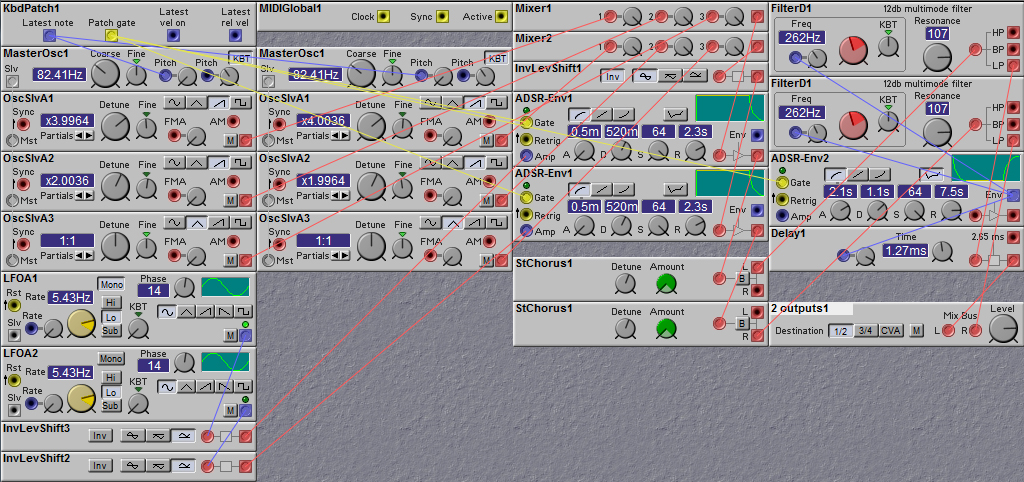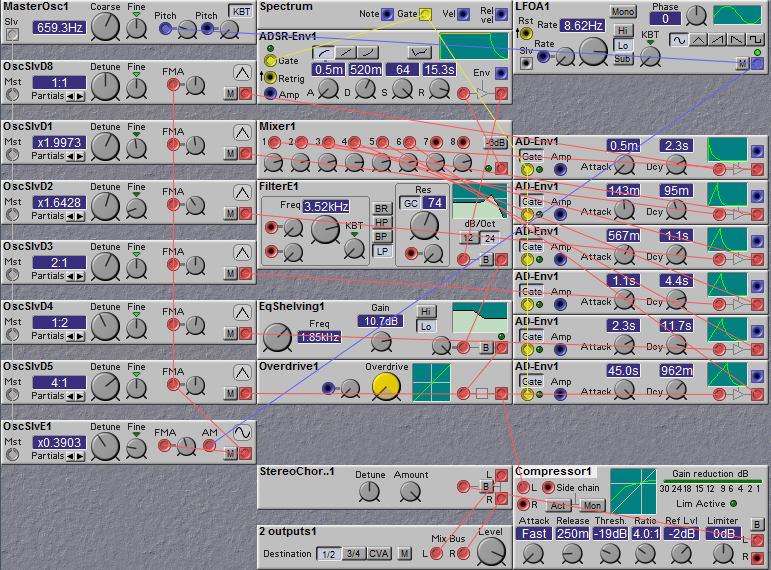Dec 10 2012
Nord Micro Modular Patch Demo

I’ve been fascinated by modular synthesis ever since I discovered what it was. Back in the mid 80s I had the good fortune to have nearly unlimited access to a massive Moog 35, two Moog 15 racks, a Moog sequencer, and a keyboard. These massive racks contained discreet purpose built modules that shared a common power source but, other than that, were completely independent of each other. One connected them with a series of 1/4″ audio plugs, sort of like one of those old fashioned telephone switchboards. While you were limited to the modules and patch cords on hand, there was a nearly limitless set of connection possibilities, some of which were never intended by the designers.

Without delving too deeply into synthesis, I’ll explain the four main tools: VCO, VCA, VCF, and Envelope Generator.
A voltage controlled oscillator creates the sound one hears. It usually can create a number of different wave forms, each with a specific and distinctive timbre. The pitch of the tone is controlled by knobs for gross and fine tuning, but can also be controlled by a voltage (+/- 5v, for example). The keyboard connects to the input of the oscillator and sends a specific voltage for each note that is depressed. It is also possible to send the signal of another VCO, or even an Envelope Generator, to the VCO to alter the pitch.
A voltage controlled amplifier is a simple tool to control the amplitude of a sound. As the voltage drops, the loudness decreases, and visa versa. Often, the VCA is modulated with a VCO to create an effect similar to a tremolo on a guitar amplifier. It can also be controlled by the EG.
The voltage controlled filter helps to shape the tone or timbre. It can do this by removing or boosting specific frequencies, or sets of frequencies, from the sound. Because the filter is voltage controlled, the amount of filtering and set of frequencies can be modulated independently, creating, for example, a ‘wah wah’ sound.
The envelope generator was not intended to directly affect the sound created by an oscillator but, rather, to produce a control voltage that can be used to alter the way other modules behave. The typical EG has four controls: Attack, Decay, Sustain, and Release. These relate to how many acoustic instruments produce sounds. For example, if you pluck a violin string, the sound starts immediately. The attack is short, and sharp. If you bow it, though, the sound grows gradually. With a plucked note, there is no sustain, so the sound decays quickly and the string soon is back to rest. With a bowed string, though, the sound can sustain indefinitely and, when you stop bowing, the sound fades out. The EG helps to create these kinds of dynamics artificially, when triggered by pressing a note on the keyboard, or through other means.
One last thing about EG: If you listen carefully to a plucked note, you will notice a few other things. 1st, the pitch goes slightly sharp for just a moment, because the player is pulling on the string. Also, the set of frequencies, the harmonic content or timbre of the sound, changes very quickly, from bright to dull. One can use the EG to control both the VCO and the VCF to simulate these variations, and create amazingly realistic sounds. That, though, has never been my interest.
Clavia is a Swedish company that was at the forefront of Virtual Analog Synthesis. VAS uses computer processing to create models of electronic circuits. Their Modular synths are similar to the massive Moog synth, above, but benefit from having a larger set of modules, and the hardware being about the same size as a paperback book. The modules are laid out and connected on one’s computer, then transferred to the unit for performance. Not only can it be used to create sounds, but also to process or effect sounds, something I intend to explore further in the future.
In preparation for an upcoming performance I spent about a month creating patches from scratch and, in some cases, heavily modifying existing patches. I used a Korg Kaossilator Pro as the primary controller for the Nord Micro Modular. This device sends midi note and controller info to the Nord, much like a keyboard, but instead it uses a touch screen with assignable key and scale settings. Although the number of control signals, via midi, is vast, I chose no more than three for each patch, because that’s how many the Pro can manage easily.
Here are some screen shots of the patches, audio demos for each, and a brief description of the other controls. [Note: The controls are as follows: y=up and down movement on the touch controller; 93=a slider next to the touch screen; 94=a knob above the slider. Each is assignable to a single, or many, parameters in each patch.]

Hear 4-8-16. Control: y=Filter, 93=Bits, 94=OD

Hear Diso Deep Mod. Control: Y=Filter, 93=Phaser Depth, 94=Clip

Hear Diso Harm.

Hear Fat Triangle. Control: Y=Filter, 93=Chorus, 94=A/R

Hear Fat Triangle 2. Control: Y=Filter, 93=Chorus, 94=ModSpeed

Hear Filt Seq. Control: Y=Filter, 93=FReso, 94=Speed

Hear Orbitron. Control: Y=Filter, 93=Bits

Hear Pedal Steel Strum, and a slightly different version. Control: Y=Filter, 93=Speed/A/R, 94=Detune

Hear Space Race. Control: Y=Filter, 93=OD, 94=ModSpeed

Hear Spitty Grit. Control: 93=A/D

Hear Sweepy Time, and a slightly different version. Control: Y=Filter, 93=OD/CH, 94=ModSpeed/FM

Hear VocoLead Control: y=Filter, 93=Octave, 94=Vibrato
You can also hear a rather thoughtlessly constructed demo that features about two thirds of these patches.
Please feel free to ask me any pertinent questions, and I’ll do my best to answer them.